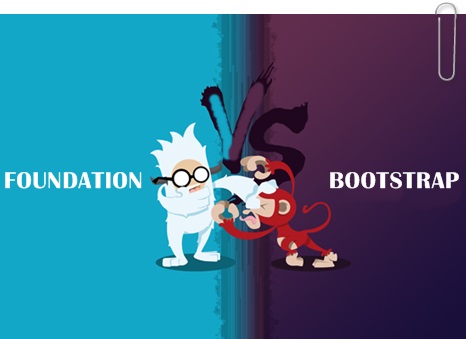Bootstrap vs. Foundation–Which is the Best Choice! Compare the Features.
While executing a web design project, one of the challenges you will face is making a choice between Bootstrap and Foundation. Well, it is not only you, but every developer working in a responsive web design company is in a fix whether to go for Bootstrap or choose Foundation. These two are currently the most sought-after design frameworks when it comes to developing a responsive website and this increases the confusion more. So, I thought of coming up with a blog post on this topic. I hope the following discussion helps you take the right decision.

Before jotting down the merits and demerits of the two popular frameworks, let’s get to know what a design framework is.
What is framework?
A framework is an assortment of tools for developing websites and mobile applications. The tools are uniformly coded (CSS and HTML) and they are the primary requisites for creating a site. The advantage of using a framework is that developers need not perform extensive coding when working on websites having similar structure. It helps developers save a lot of time. As a result, they can focus on other crucial aspects and boost their productivity.
When you want to create a highly functional and user-friendly website, you cannot accomplish the job without a proper design framework. It is worth mentioning here that both Bootstrap and Foundation are fully responsive frameworks. A developer should possess a wide base of knowledge in these two disciplines in order to work efficiently for a responsive web design company.
Now, let’s move on to the main topic of discussion.
Bootstrap vs. Foundation :
Flexible Grid System – You must be aware of the fact that the grid system is the chief feature of a design framework. This is the aspect that helps developers create layouts quickly. When there is a need to make any modification, the grid system aids a developer to carry out the changes with ease and speed.
So, when it comes to an efficient grid system, Foundation seems to be ahead of Bootstrap. It is a bigger framework which is fully responsive. For years, Foundation remained as the only choice for developers. But, the scene is different now as Bootstrap is equipped with this feature as well with the difference that the rules for building grids are not the same as in the case of Foundation.
Good Sizing Units – We developers need a great front-end framework to analyze widths and typography efficiently. Bootstrap makes use of pixels, while Foundation goes for rems to perform the analysis. Although the two sizing units differ from each other in terms of functionality, both are good when it comes to excellent end-result.
For beginners, pixels i.e. Bootstrap may seem to be a better choice. On the other hand, rems i.e. Foundation is much more favoured by veteran developers. Being a developer at a responsive web design company, I have always gone for rems since it is a relative unit and is perfect for responsive designs. Now, this is a personal preference. The means for achieving usability in a design is not the same for every designer.
Extensive list of built-in components – It may seem at first that the two frameworks have almost the same components, but a closer look will reveal the differences. Foundation consists of the following components.
• Built-in form validation via Abide
• Interchange
• Off-canvas navigation
• Pricing tables, right-to-left support and tours
There are many more features to be found in Foundation. On the other hand, Bootstrap is not equipped with that much of features, but the default setting of its components are more apt when it comes to creating a unique website. It is also equipped with responsive embeds.
Effective customization – In this respect, there is a tough competition between Foundation and Bootstrap. In terms of options for customization, Foundation is a better choice. Bootstrap offers every element that is required to increase the loading speed of a website.
The default look of Foundation is set in a way that a developer finds it much easier to change it by adding aesthetic elements. But, Bootstrap’s default look is not like this; as a result, it poses problems for developers when it comes to customization.
Number of themes – Bootstrap defeats Foundation in this matter. The former offers a wide range of themes that can be accessed rapidly. On the other hand, Foundation does offer themes readily but they are not plentiful. This is a major reason why most developers opt for Bootstrap.
So, it is clear from the above discussion that both Bootstrap and Foundation have their share of advantages and disadvantages. You should make the final decision only after weighing the plus and minus points of the two. You also need to keep in mind the project requirements.
Opt for the best that makes a project successful and gets your responsive web design company more crucial projects in future.











Leave a Reply